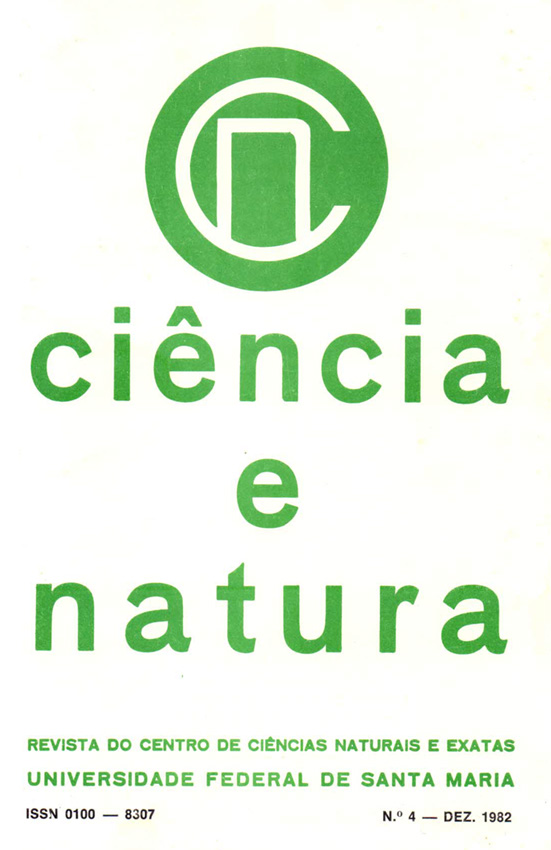Analytical balance of the wood of Hovenia dulcis Thunb., of the population in the Estação Experimental of Silvicultura of Boca of the Monte, Santa Maria, RS
DOI:
https://doi.org/10.5902/2179460X24953Abstract
This work consisted of an analytical balance through chemical methods of the main wood components of the Hovenia dulcis Thunb species (Rhamnaceae).
Being a harwood species, the total extrative fractions, lignin and ashes, presented themselves within normal values.
The celulose and sugars of the hexose type presented high contentes and this species presentes a possibility to be used as raw material for industrial purposes, such as pulp and paper and by products from saccharification of the wood.
Downloads
References
ÁRVORES. Como, quando e onde plantar, onde comprar. Porto Alegre, Fecotrigo, r.d. 15 p.
ASSOCIAÇAO TECNICA BRASILEIRA DE CELULOSE E PAPEL. São Paulo, Determinação de umidade: ABCP-M2/71. São Paulo, 1971.
ASSOCIAÇAO TECNICA BRASILEIRA DE CELULOSE E PAPEL. São Paulo. Solubilidade da madeira em água quente. ABCP-M4/68. São Paulo, 1968.
BARRICHELO, L.E.G. Apontamentos de química da madeira. São Paulo, USP. 49p.
COZZO, D. Tecnologia de La forestación in Argentina y America Latina. Buenos Aires, Hemisfério Sur, 1976. p.589-9.
KENICHI, K. et alii. New sapogenin in the saponin of Zisyphus jujuba, Hovenia dulcis, and Bacopa monniera. Phytochemistry. 13 (12):2928-32.1974.
MAKOTO, T. et alii. New peptide alkaloids from Hovenia dulcis and H. tomentella, Phytochemistry. 12(12):2985-6,1973.
METCALFE, C.R. & CHALK, L. Anatomy of the dicotyledon. Oxford, Clanendom, 1972. 1500 p.
NIKITIN, N.I. The chemistry of celulose and wood. Jerusalém, Israel Program for Scientific Translation, 1966. 691p.
OLIVEIRA, J.S. Análise química de madeiras tropicais. Revista Ciência Agronômica. Lisboa, 4(3):1-32.1971.
OSAMU, I. et alii. Carbohydrate structures of three new saponins from the root bark of hovenia dulcis (Rhamnaceae). Journal Chemical:Society. (11):1289-23,1978.
PANSHIN, H.B. Forest products. 2.ed. New York, Mc Graw Hill Book,1962. 538p.
REITZ. R. et alii. Flora ilustrada catarinense; Rhamnaceae. Itajaí. 1972. 50p.
TECHNICAL ASSOCIATION OF THE PULP AND PAPER INDUSTRY. Determinação de cinzas: TAPPI T15m-58; 1958.
TECHNICAL ASSOCIATION OF THE PULP AND PAPER INDUSTRY. Determinação de pentoses; TAPPI T19m-50. 1950.
USHER. G. A dictionary of plants by man. London, Constable, 1974. 691p.
WINNACKER. K. & WEINGAERTNER. E. Tecnologia química. Barcelona. Gustavo Gili, 1961. v.5.
Downloads
Published
How to Cite
Issue
Section
License
To access the DECLARATION AND TRANSFER OF COPYRIGHT AUTHOR’S DECLARATION AND COPYRIGHT LICENSE click here.
Ethical Guidelines for Journal Publication
The Ciência e Natura journal is committed to ensuring ethics in publication and quality of articles.
Conformance to standards of ethical behavior is therefore expected of all parties involved: Authors, Editors, Reviewers, and the Publisher.
In particular,
Authors: Authors should present an objective discussion of the significance of research work as well as sufficient detail and references to permit others to replicate the experiments. Fraudulent or knowingly inaccurate statements constitute unethical behavior and are unacceptable. Review Articles should also be objective, comprehensive, and accurate accounts of the state of the art. The Authors should ensure that their work is entirely original works, and if the work and/or words of others have been used, this has been appropriately acknowledged. Plagiarism in all its forms constitutes unethical publishing behavior and is unacceptable. Submitting the same manuscript to more than one journal concurrently constitutes unethical publishing behavior and is unacceptable. Authors should not submit articles describing essentially the same research to more than one journal. The corresponding Author should ensure that there is a full consensus of all Co-authors in approving the final version of the paper and its submission for publication.
Editors: Editors should evaluate manuscripts exclusively on the basis of their academic merit. An Editor must not use unpublished information in the editor's own research without the express written consent of the Author. Editors should take reasonable responsive measures when ethical complaints have been presented concerning a submitted manuscript or published paper.
Reviewers: Any manuscripts received for review must be treated as confidential documents. Privileged information or ideas obtained through peer review must be kept confidential and not used for personal advantage. Reviewers should be conducted objectively, and observations should be formulated clearly with supporting arguments, so that Authors can use them for improving the paper. Any selected Reviewer who feels unqualified to review the research reported in a manuscript or knows that its prompt review will be impossible should notify the Editor and excuse himself from the review process. Reviewers should not consider manuscripts in which they have conflicts of interest resulting from competitive, collaborative, or other relationships or connections with any of the authors, companies, or institutions connected to the papers.







